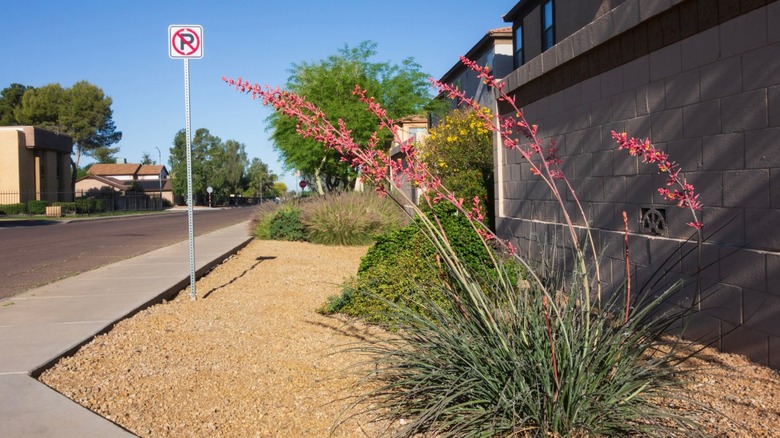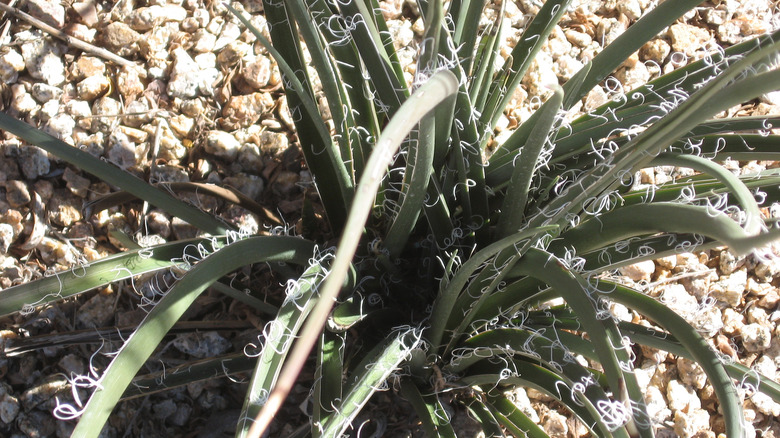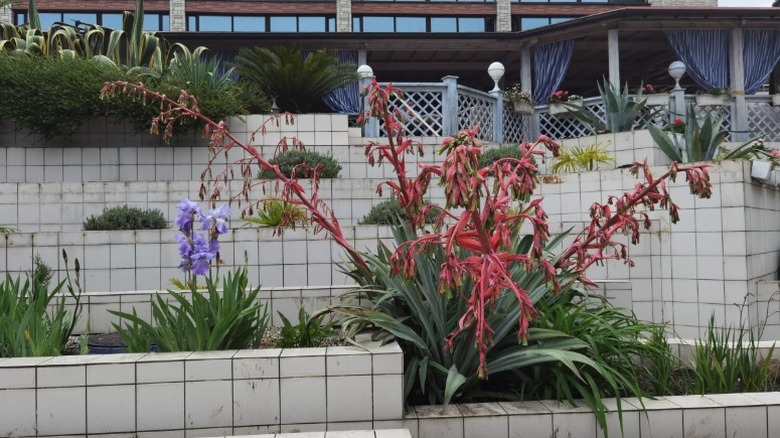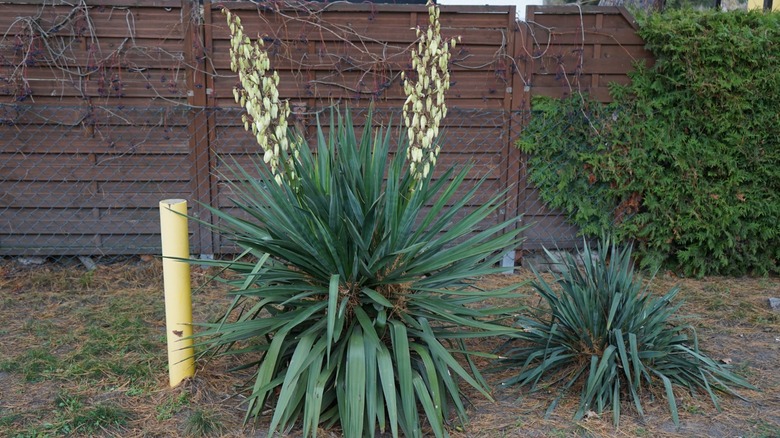Red Yucca Look-Alike Plants That Also Attract Hummingbirds
It's easier than you think to diversify your landscaping while sticking to the same aesthetic that you know and love. If you live in a hot, dry area, one of the most popular plants is the red yucca (Hesperaloe parviflora), also known as hummingbird yucca. When you find a plant that you love, like red yucca, it's tempting to plant it all over your yard. Instead, seek out lookalike plants with similar qualities that will also thrive in hot and dry conditions. Red yucca, which is a member of the century plant family, has a unique look, with long, thin leaves arching at the base of tall flower stalks. It grows in clumps, between 3 and 5 feet high and 4 and 6 feet wide. It originally was found in desert areas in Texas and northeastern Mexico, but is hardy in zones 6 through 10 in the U.S.
Despite its unusual look, there are several other plants reminiscent of the red yucca that will look at home next to it in your garden. If you want similar-looking plants to the red yucca, look for species with long flower stalks rising above narrow green, spiky leaves. Red yucca is a native red flower you should be using to attract hummingbirds to your yard, providing nectar in its tubular flowers, but it's not your only choice. Attract hummingbirds to your yard and enjoy the look of the red yucca by choosing giant hesperaloe (Hesperaloe funifera), Mexican lily (Beschorneria yuccoides), and curlyleaf yucca (Yucca filamentosa). These species grow well in the same climate conditions as red yucca and attract hummingbirds, but have little nuances to add dimension to your garden.
The larger, but related, giant hesperaloe
A plant in the same family as red yucca, giant hesperaloe is a perennial plant that grows mainly in Texas. In its native habitat, it grows from San Luis Potosi through Nuevo Leon and Coahuila to the southern part of Texas. Also known as New Mexico false yucca, it is similar to red yucca except it displays yellow or white flowers. However, these flowers also provide nectar that can sustain hummingbirds traveling through your yard. Giant hesperaloe also grows much larger than red yucca. Its name is apt, because this species grows straight leaves that can spread up to 6 feet in height and width. The leaves typically stay green all winter long. Its white flowers grow on stalks up to 12 feet high, compared to 4 to 6 feet high flower stalks on the red yucca.
Giant hesperaloe is hardy down to zone 6. It does not require a lot of maintenance and grows well in dry or moist soil conditions. Considering its native habitat in the desert, this plant uses little water and is highly tolerant of drought. Ensure proper soil drainage and full sun to make the most of this spring and summer-blooming plant. Recommended landscaping uses include as a container plant, pool accent, or mass planting.
The clumping and drought-tolerant Mexican lily
The Mexican lily is also called yucca-leaved beschorneria due to its resemblance to yucca species. However, the leaves of the Mexican lily are distinct, lacking the stiff nature of a yucca plant. Its overall form resembles the red yucca, with flower stalks growing above its green, spreading leaves. This evergreen plant has 1 to 3 inch-sized, bell-shaped flowers that grow on long stalks. Red bracts grow off these stalks, surrounding green petals. The reddish flowers and stalks are similar to red yucca, as well as the green, succulent leaves that grow in clumps below the flowers. The little flowers attract hummingbirds seeking nectar, making it a good alternative to the red yucca.
A member of the agave family, Mexican lily is an herbaceous perennial that forms clumps and is resistant to drought. It is native to northern Mexico, particularly on rocky slopes and ravines in the states of Veracruz, Hidalgo, and Puebla. This plant is hardy from zones 8 through 11 and is not very tolerant of frost. It cannot be grown well outdoors in areas where temperatures regularly go below 23 degrees Fahrenheit. This red yucca lookalike grows well in silt, sand, or shallow rocky soil. It's one of the best outdoor plants if you live in a dry climate because the plants don't need a lot of water and can withstand occasionally dry soil conditions.
The distinctly-shaped curlyleaf yucca
Curlyleaf yucca is similar to red yucca, being a drought-resistant, hummingbird-attracting plant. But instead of red, this plant has white flowers that bloom from April to June, growing above the spiky leaves at the base of the plant in tall spikes. Along with attracting hummingbirds, this plant supports the white yucca moth and acts as a host for yucca giant-skipper and Cofaqui giant-skipper larvae. Unlike red yucca, curlyleaf yucca is a true yucca species. Also known as Adam's needle yucca and spoonleaf yucca, curlyleaf yucca can be distinguished from other yucca plants by its sword-shaped leaves that have a slight upturn like a spoon.
This plant is an evergreen shrub with a clumping habit that is low-maintenance and resistant to wildlife, erosion, and heat. Native to the southeastern U.S., including Alabama, Florida, Texas, and California, this yucca species was commonly used by Native Americans for food, medicine, and soap. Curlyleaf yucca grows in Hardiness Zones 4 through 10 and is not picky about soil conditions, growing well in clay, silt, sand, or rocky ground. However, avoid mistakes everyone makes when growing yucca in the garden, such as providing too much water to this drought-resistant shrub. Curlyleaf yucca is not a very tall yucca plant, usually staying small at 3 feet tall, but capable of growing to 8 feet tall.



